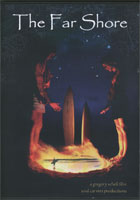
The Far Shore 2002
Distributed by Mutiny Media, Inc., PO Box 328, San Juan Capistrano 92693-0328; 949.443.9020
Produced by Soul Carvers Productions
Directed by Gregory Schell
DVD, color, 57 min.
College - Adult
Surfing, Surf Culture
Date Entered: 07/03/2007
Reviewed by Ciara Healy, Media Services Librarian, Wake Technical Community College, Raleigh, NCSome surf films focus almost exclusively on visuals of waves, surfers riding waves and surfers talking about surfing. The Far Shore benefits from talking about surf culture and from talking to surfers from the 1970s who, it seems, have more to say about surfing and its role in their lives than the current champions.
Far Shore covers the era in surf history called “adventure surfing” which was popularized in the early 1970s and chronicled in Surfer magazine. Quite different from Endless Summer with the surfers dressing in suit coats and ties to fly to the far side of the world in search of the perfect wave, the adventure surfers Kevin Naughton and Craig Peterson strike out in a VW Bus for the remote parts of South America and beyond in search of every place’s perfect wave.
Naughton wrote for Surfer magazine as a freelancer and Peterson, at only 17 years old, was an already accomplished surf photographer when they left for South America from California in 1972 in search of adventure. The film includes still images, Super 8 footage and plenty of conversation, interviews and analysis of 70’s surf culture from Naughton, Peterson and others, especially those at the magazine who edited their dispatches from everywhere. They followed the adventure surf life for 10 years, sometimes eating bread and honey for days at a time or laying up under mosquito netting in Nigeria recovering from dysentery. Adventure surfing is basically taking a surfboard and a route to the ocean and little else. This duo appeared in Surfer magazine often enough that they were called just Jeff and Craig on the cover.
Far Shore offers insight into the phenomenon of adventure surfing, the editorial culture at Surfer magazine in the 1970s and reflections on a particular time in surf culture. When coupled with anecdotes from Jeff and images shot by Craig the film takes on the best characteristics of a travelogue. It also provides a great contrast to current, visuals-driven surf films that have a lot of style but less substance. Jeff and Craig have had time to reflect on their experiences, make livings for them selves outside of surf culture (Jeff runs a nursery and greenhouse with his wife) and can put current competition and tourism surf culture in perspective.
I recommend this surf film highly if only because it is about surfing and surfers (Jeff and Craig still surf) who have a great perspective on surf culture, and adventure surfing in particular, that is almost absent from films that focus on younger, superstar surfers. This film would be a good addition to collections that support surf culture studies, travel/hospitality/tourism curricula, filmmaking, print journalism, American studies, pop culture studies or sociology.